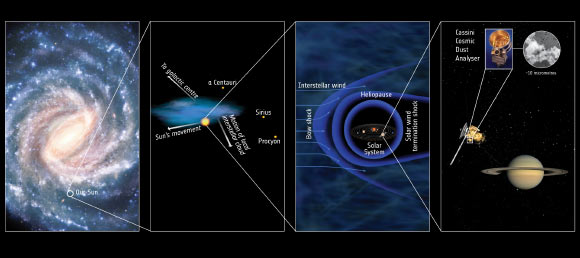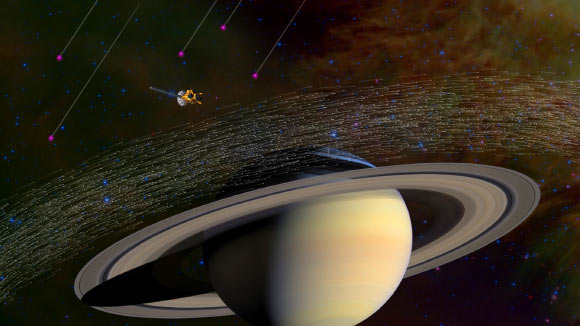The NASA/ESA Cassini spacecraft has detected the faint but distinct signature of dust coming from outside our Solar System, from the Local Interstellar Cloud — an almost empty bubble of gas and dust we are traveling through with a distinct direction and speed.

This graphic summarizes the location of Saturn, and the Solar System, with respect to the Local Interstellar Cloud, and our place in the Milky Way Galaxy. In the final image an artist impression of the Cassini probe is shown (not to scale) with Saturn. The dust grain shown is not a true representative of what the Cosmic Dust Analyser detects, as the interstellar dust grains are destroyed upon impact; what is shown here is an interplanetary dust particle, likely originating from a comet or asteroid, collected in Earth’s atmosphere, but shown here for illustrative purposes. Image credit: ESA / NASA / JPL / Space Science Institute.
Cassini has been in orbit around Saturn since 2004, studying the giant planet, its rings and satellites. It has also sampled millions of ice-rich dust grains with its Cosmic Dust Analyser instrument.
The vast majority of the sampled microscopic grains originate from active jets that spray from the surface of Saturn’s moon Enceladus. But 36 stick out from the crowd – and scientists conclude they came from beyond our Solar System.
In the 1990s, the ESA/NASA Ulysses mission made the first in-situ discovery of interstellar dust, later confirmed by NASA’s Galileo spacecraft. The dust was traced back to the Local Interstellar Cloud.
“From that discovery, we always hoped we would be able detect these interstellar interlopers at Saturn with Cassini: we knew that if we looked in the right direction, we should find them,” said Dr. Nicolas Altobelli of the European Space Agency and lead author of the study reporting the results in the journal Science.
“And indeed, on average, we have captured a few per year, traveling at high speed and on a specific path quite different to that of the usual icy grains we collect around Saturn.”
“Interstellar dust is one of the last bastions of the unknown in space, its individual particles being only about 200 nm in size and very hard to find,” added co-author Prof. Mario Trieloff, from the University of Heidelberg.
The dust grains were speeding through at over 72 000 km/h, fast enough to avoid being trapped inside the Solar System by Saturn’s – or even the Sun’s – gravity.

Of the millions of dust grains Cassini has sampled at Saturn, 36 grains appear to have come from beyond our Solar System. Scientists believe these special grains have interstellar origins because they moved much faster and in different directions compared to dusty material native to Saturn. Image credit: NASA / JPL-Caltech.
Cassini analyzed the composition of the grains for the first time, showing them to be made of a very specific mixture of minerals, not ice.
They all had a surprisingly similar chemical make-up, containing major rock-forming elements like magnesium, silicon, iron and calcium in average cosmic proportions.
Conversely, more reactive elements like sulfur and carbon were found to be less abundant compared to the average.
“Cosmic dust is produced when stars die, but with the vast range of types of stars in the Universe we naturally expected to encounter a huge range of dust types over the long period of our study,” said co-author Dr. Frank Postberg, also from the University of Heidelberg.
“Surprisingly, the grains we’ve detected aren’t old, pristine and compositionally diverse like the stardust grains we find in ancient meteorites,” Prof. Trieloff said.
“They have apparently been made rather uniform through some repetitive processing in the interstellar medium.”
The scientists speculate that dust in a star-forming region could be destroyed and recondense multiple times as the shockwaves from dying stars passed through, before the resulting similar grains ended up streaming towards our Solar System.
_____
N. Altobelli et al. 2016. Flux and composition of interstellar dust at Saturn from Cassini’s Cosmic Dust Analyzer. Science, vol. 352, no. 6283, pp. 312-318; doi: 10.1126/science.aac6397







